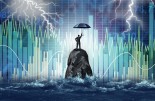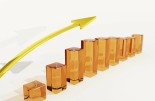Han Dieperink: Volatility as the ultimate source of alpha
Han Dieperink: Volatility as the ultimate source of alpha

This column was originally written in Dutch. This is an English translation.
By Han Dieperink, written in a personal capacity
In recent years, financial markets have been behaving in a way that is challenging traditional investment theory. Whereas volatility used to have a predictable heartbeat with regular cycles, we are now increasingly seeing a bipolar pattern that is forcing professionals to rethink their entire risk perception.
This shift is not a temporary phenomenon, but a structural transformation that strikes at the heart of successful investing. Financial markets now react more extremely than ever before in crisis situations, while volatility is artificially suppressed in “normal” periods. This dichotomy creates a new reality in which traditional risk models fail and new strategies are required. The implications extend far beyond short-term trading. They touch on the fundamentals of portfolio construction, risk management and return expectations.
The misconception of risk
The biggest misconception in modern investing concerns the definition of risk itself. Most investors consider volatility to be the primary risk, but this is a fundamental error in thinking that can prove costly. The real risk for investors is not that a stock falls 5% today and rises 3% tomorrow – these are temporary movements that average out over longer periods and are part of normal market functioning.
The real risk is permanent loss of purchasing power: the inability to buy more with the available capital in ten or twenty years than is possible today. This fundamental threat is often overlooked by investors who obsessively focus on short-term fluctuations. In contrast, cash guarantees a loss of purchasing power through inflation. With an average inflation rate of 2.5%, the value of savings halves every 28 years – a mathematical certainty that is far more frightening than any price fluctuation.
This misperception of risk leads to suboptimal decisions, with investors fleeing to seemingly safe instruments that are guaranteed to destroy value, while avoiding instruments that have historically preserved and expanded purchasing power. Volatility is no longer the enemy, but a potential ally of the long-term investor.
Volatility as the exclusive source of alpha
In financial theory, alpha is defined as the return above the market – the surplus that active investors can achieve through superior selection, timing or strategy. In a hypothetical perfectly efficient market, alpha would not exist, because all available information would be immediately and accurately reflected in prices. Every investor would achieve identical, risk-adjusted returns.
But volatility breaks this theoretical efficiency and creates systematic opportunities for those who understand and exploit it. Without price fluctuations, all investors would indeed achieve identical returns, limited to the natural growth of the underlying economy. Volatility enables the crucial difference between average and outstanding results by creating buying and selling opportunities that are fundamentally separate from intrinsic value.
This dynamic is exponentially amplified in the current market environment. Extreme price movements are no longer anomalies that are corrected – they are the new reality in which systematic opportunities arise for investors who can interpret and exploit them. Volatility offers the opportunity to buy low and sell high, which is the absolute essence of successful investing and the only remaining source of structural alpha in modern markets.
The three drivers of modern volatility
1) Social media: from rumours to price explosions
The biggest change in modern markets comes from the democratisation of information and the organisation of retail investors via social media platforms. Platforms such as Reddit, Twitter and TikTok have transformed a previously fragmented group of small investors into a coordinated force that regularly surprises and sometimes destroys traditional institutional players.
The GameStop phenomenon of 2021 dramatically illustrates this transformative power. A community of mostly young investors on Reddit's WallStreetBets mobilised millions of people within days to buy a heavily shorted stock en masse. The result was unprecedented: GameStop rose 1,500% in two weeks, with large hedge funds losing billions. This was not the result of fundamental analysis, superior information or traditional valuation models, but of collective action coordinated through memes, viral posts and social pressure.
This development has permanently shifted the balance of power in markets. Social media can turn sentiment around in a matter of hours and generate massive capital flows that are completely detached from traditional valuation metrics. Corona was the first real social media pandemic, with fear and optimism spreading virally and amplifying market reactions that would have been much more limited without digital amplification.
Geopolitical developments also have a much more direct and extreme impact on markets through social media. Tweets from political leaders, viral videos from conflict zones or trending hashtags can destroy or create billions in market value within minutes. This democratisation of market influence makes volatility more unpredictable but also exploitable for those who can read and anticipate social media sentiment.
2) Passive index investing: the blind flow of capital
The second fundamental factor is the explosive growth of passive investing, a trend that has structurally disrupted natural price formation in markets. Index funds and ETFs now manage trillions worldwide, with daily inflows often amounting to tens of billions. These funds operate according to a simple mechanism: they buy shares purely because they are included in an index, regardless of price, quality, valuation or fundamental analysis.
This mechanism creates a systematic bias whereby popular index components are artificially upgraded. If Apple makes up 7% of the S&P 500 index, then Apple automatically receives 7% of every new dollar that flows into an S&P 500 index fund, regardless of whether the stock is cheap, expensive, or even fundamentally sound. These mechanical capital flows disrupt the natural price formation that was traditionally based on individual company analysis and relative valuation.
In normal market conditions, this mechanism dampens volatility because there is always a systematic “buyer of last resort”. Index funds continue to buy as long as there is inflows, which stabilises prices and limits extreme movements. But during crisis situations, this mechanism backfires and dramatically amplifies movements.
The coronavirus crash of March 2020 demonstrated this effect on an unprecedented scale.
When investors withdraw money from index funds en masse, these funds have to sell blindly to provide liquidity, regardless of whether individual components have become historically cheap. Within four weeks, the market saw its biggest ever decline, driven by automatic sales of index funds responding to panicked investors.
The result was absurd: companies such as Microsoft and Apple – with strong balance sheets, growing profits and solid future prospects – fell as sharply as ailing airlines and cruise companies that were directly affected by lockdown measures. These sales created historic buying opportunities for investors who could distinguish fundamental value from mechanical market movements.
3) Algorithmic trading: emotions on the motorway
The third transformative factor is the dominance of algorithmic trading, in which computers autonomously execute trades based on pre-programmed rules, artificial intelligence and machine learning algorithms. These systems now execute around 80% of all trading transactions and can react to market movements, news reports or technical signals in milliseconds.
In stable market conditions, these algorithms increase efficiency by reducing bid-ask spreads, providing liquidity and immediately correcting small price inefficiencies. They function as a kind of market lubricant that reduces transaction costs and refines price formation. However, in times of stress or uncertainty, these systems dramatically amplify movements through a cascade effect in which algorithms react to other algorithms without fundamental considerations.
The flash crash of 6 May 2010 remains the most extreme example of this mechanism. In just 36 minutes, nearly 10% of the total value of the US stock market disappeared. The trigger was a relatively small sell order that caused an avalanche of algorithmic reactions. Computers sold because other computers sold, in a self-reinforcing cycle unrelated to fundamental business value or economic reality.
Modern algorithmic trading has become even more complex with the integration of artificial intelligence. New AI systems analyse not only traditional price data and volume, but also news feeds, social media sentiment, satellite images of parking lots at shopping centres, credit card transactions and even weather patterns. This technological evolution makes markets even more responsive to external stimuli and increases the likelihood of extreme movements that are completely unrelated to traditional fundamental analysis.
The paradox of modern market efficiency
These three factors create a fascinating paradox that goes to the heart of modern market theory. On the one hand, markets are more informationally efficient than at any other time in history.
News spreads continuously around the world, economic data is available to every investor within seconds, algorithms detect and correct minor inefficiencies within milliseconds, and social media provides unprecedented transparency in corporate communications.
This informational efficiency should theoretically lead to more stable, predictable markets in which prices accurately reflect intrinsic value. But the reality is the opposite. Markets are more emotionally volatile than ever before. Social media amplify sentiment to extreme proportions, passive money flows completely ignore valuation and fundamental analysis, and machines reinforce movements without distinguishing between panic and reality.
This paradox explains why traditional sources of alpha are systematically disappearing while volatility remains the last structural source of excess return. Information advantages that once favoured institutional investors are levelled out within seconds by algorithms and social media. Transaction costs have fallen to almost zero, eliminating cost advantages. Even superior analysis is quickly imitated and arbitrage eliminated by faster systems.
But volatility remains, because it stems from human and mechanical reactions to information, not from the information itself. As long as markets consist of people and machines that react emotionally, irrationally or mechanically to events, there will be periods of extreme overvaluation and undervaluation that offer opportunities for patient, contrarian investors.
Buffett's volatility advantage
Warren Buffett's Berkshire Hathaway is perhaps the best empirical validation of volatility as a source of structural alpha. Berkshire consistently achieved its best relative results during the most volatile and chaotic market periods in modern financial history.
During the oil crisis of 1973-74, when markets fell due to geopolitical uncertainty and energy shortages, Buffett was able to buy shares in excellent companies at historically low valuations. The crash of 1987, which wiped out 22% of market value in a single day, offered similar opportunities. The dot-com implosion of 2000-2002 allowed Buffett to take advantage of the extremely irrational valuations that arose when technology stocks with no profits were trading at hundreds of times their revenue.
The financial crisis of 2008-2009 was perhaps Buffett's greatest triumph in exploiting extreme volatility. While other investors sold in panic and hoarded liquidity, Berkshire invested billions in companies such as Goldman Sachs, General Electric and Bank of America on terms that would have been unthinkable in normal times. These investments generated tens of billions in profits over the following years.
Buffett's strategy illustrates the core principle: “Be greedy when others are fearful, and fearful when others are greedy.” This timeless wisdom takes on new relevance and urgency in hyper-volatile modern markets. Extreme movements create extreme opportunities, but only for investors who are psychologically and financially prepared to act against the tide.
Conclusion: The last alpha
In a world where traditional information advantages are levelled within seconds, transaction costs are approaching zero, and algorithms immediately arbitrage every small inefficiency, volatility remains the last source of structural excess returns. This reality requires a fundamental change in thinking about risk, reinterpreting movements from threats to opportunities.
For professional investors who embrace this new paradigm, unprecedented opportunities arise in highly correlated markets that produce extreme movements with systematic regularity. Beating volatility requires discipline, patience, liquidity and a long-term perspective – but today's hyper-reactive markets reward these qualities more richly than at any other time in financial history.
The question is no longer whether extreme volatility will increase – that is a mathematical certainty given the underlying drivers. The question is whether future investors will have the courage, discipline and strategic flexibility to embrace movements rather than fear them. In extreme price swings lies the last structural alpha, waiting for those who understand that in the modern world, volatility is no longer a by-product of markets, but their primary characteristic.
Investors who successfully navigate this transition will not only survive in the new volatile reality – they will thrive by capitalising on the fear, panic and mechanical movements of others. In a world full of uncertainty, this may be the only certainty that remains: volatility is permanent, and therefore a permanent source of alpha for those who know how to deal with it.








